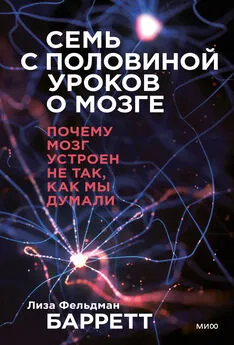Лиза Барретт - Как рождаются эмоции
- Название:Как рождаются эмоции
- Автор:
- Жанр:
- Издательство:Манн, Иванов и Фербер
- Год:2018
- Город:Москва
- ISBN:нет данных
- Рейтинг:
- Избранное:Добавить в избранное
-
Отзывы:
-
Ваша оценка:
Лиза Барретт - Как рождаются эмоции краткое содержание
Эта книга совершает революцию в понимании эмоций, разума и мозга. Вас ждет захватывающее путешествие по удивительным маршрутам, с помощью которых мозг создает вашу эмоциональную жизнь. Вы научитесь по-новому смотреть на эмоции, свои взаимоотношения с людьми и в конечном счете на самих себя. На русском языке публикуется впервые.
Как рождаются эмоции - читать онлайн бесплатно ознакомительный отрывок
Интервал:
Закладка:
Mervis, Carolyn B., and Eleanor Rosch. 1981. “Categorization of Natural Objects.” Annual Review of Psychology 32 (1): 89–115.
Merz, Emily C., Tricia A. Zucker, Susan H. Landry, Jeffrey M. Williams, Michael Assel, Heather B. Taylor, Christopher J. Lonigan, Beth M. Phillips, Jeanine Clancy-Menchetti, and Marcia A. Barnes. 2015. “Parenting Predictors of Cognitive Skills and Emotion Knowledge in Socioeconomically Disadvantaged Preschoolers.” Journal of Experimental Child Psychology 132: 14–31.
Mesman, Judi, Harriet Oster, and Linda Camras. 2012. “Parental Sensitivity to Infant Distress: What Do Discrete Negative Emotions Have to Do with It?” Attachment and Human Development 14 (4): 337–348.
Mesquita, Batja, and Nico H. Frijda. 1992. “Cultural Variations in Emotions: A Review.” Psychological Bulletin 112 (2): 179–204.
Mesulam, M.-Marcel. 2002. “The Human Frontal Lobes: Transcending the Default Mode Through Contingent Encoding.” In Principles of Frontal Lobe Function , edited by Donald T. Stuss and Robert T. Knight, 8–30. New York: Oxford University Press.
Metti, Andrea L., Howard Aizenstein, Kristine Yaffe, Robert M. Boudreau, Anne Newman, Lenore Launer, Peter J. Gianaros, Oscar L. Lopez, Judith Saxton, and Diane G. Ives. 2015. “Trajectories of Peripheral Interleukin-6, Structure of the Hippocampus, and Cognitive Impairment over 14 Years in Older Adults.” Neurobiology of Aging 36 (11): 3038–3044.
Miller, Andrew H., Ebrahim Haroon, Charles L. Raison, and Jennifer C. Felger. 2013. “Cytokine Targets in the Brain: Impact on Neurotransmitters and Neurocircuits.” Depression and Anxiety 30 (4): 297–306.
Miller, Antonia Elise. 2010. “Inherent (Gender) Unreasonableness of the Concept of Reasonableness in the Context of Manslaughter Committed in the Heat of Passion.” William and Mary Journal of Women and the Law 17: 249.
Miller, Gregory E., and Edith Chen. 2010. “Harsh Family Climate in Early Life Presages the Emergence of a Proinflammatory Phenotype in Adolescence.” Psychological Science 21 (6): 848–856.
Mitchell, Robert W., Nicholas S. Thompson, and H. Lyn Miles. 1997. Anthropomorphism, Anecdotes, and Animals . Albany, NY: SUNY Press.
Mobbs, Dean, Hakwan C. Lau, Owen D. Jones, and Christopher D. Frith. 2007. “Law, Responsibility, and the Brain.” PLOS Biology 5 (4): e103. doi:10.1371/journal.pbio.0050103.
Montgomery, Ben. 2012. “Florida’s ‘Stand Your Ground’ Law Was Born of 2004 Case, but Story Has Been Distorted.” Tampa Bay Times , April 14. http://www.tampabay.com/news/publicsafety/floridas-stand-your-ground-law-was-born-of-2004-case-but-storyhas-been/1225164.
Monyak, Suzanne. 2015. “Jury Awards $2.2M Verdict Against Food Storage Company in ‘Defecator’ DNA Case.” Daily Report , June 22. http://www.dailyreportonline.com/id=1202730177957/Jury-Awards-22M-Verdict-Against-Food-Storage-Company-in-Defecator-DNA-Case.
Moon, Christine, Hugo Lagercrantz, and Patricia K. Kuhl. 2013. “Language Experienced in Utero Affects Vowel Perception After Birth: A Two-Country Study.” Acta paediatrica 102 (2): 156–160.
Moore, Shelby A. D. 1994. “Battered Woman Syndrome: Selling the Shadow to Support the Substance.” Howard Law Journal 38 (2): 297.
Morell, Virginia. 2013. Animal Wise: How We Know Animals Think and Feel . New York: Broadway Books.
Moriguchi, Y., A. Negreira, M. Weierich, R. Dautoff, B. C. Dickerson, C. I. Wright, and L. F. Barrett. 2011. “Differential Hemodynamic Response in Affective Circuitry with Aging: An fMRI Study of Novelty, Valence, and Arousal.” Journal of Cognitive Neuroscience 23 (5): 1027–1041.
Moriguchi, Yoshiya, Alexandra Touroutoglou, Bradford C. Dickerson, and Lisa Feldman Barrett. 2013. “Sex Differences in the Neural Correlates of Affective Experience.” Social Cognitive and Affective Neuroscience 9 (5): 591–600.
Morrison, Adele M. 2006. “Changing the Domestic Violence (Dis) Course: Moving from White Victim to Multi-Cultural Survivor.” UC Davis Law Review 39: 1061–1120.
Murai, Chizuko, Daisuke Kosugi, Masaki Tomonaga, Masayuki Tanaka, Tetsuro Matsuzawa, and Shoji Itakura. 2005. “Can Chimpanzee Infants (Pan Troglodytes) Form Categorical Representations in the Same Manner as Human Infants (Homo Sapiens)?” Developmental Science 8 (3): 240–254.
Murphy, G. L. 2002. The Big Book of Concepts . Cambridge, MA: MIT Press.
Mysels, David J., and Maria A. Sullivan. 2010. “The Relationship Between Opioid and Sugar Intake: Review of Evidence and Clinical Applications.” Journal of Opioid Management 6 (6): 445–452.
Naab, Pamela J., and James A. Russell. 2007. “Judgments of Emotion from Spontaneous Facial Expressions of New Guineans.” Emotion 7 (4): 736–744.
Nadler, Janice, and Mary R. Rose. 2002. “Victim Impact Testimony and the Psychology of Punishment.” Cornell Law Review 88: 419.
National Institute of Mental Health. 2015. “Research Domain Criteria (RDoC).” http://www.nimh.nih.gov/research-priorities/rdoc/.
National Institute of Neurological Disorders and Stroke. 2013. “Complex Regional Pain Syndrome Fact Sheet.” http://www.ninds.nih.gov/disorders/reflex_sympathetic_dystrophy/detail_reflex_sympathetic_dystrophy.htm.
National Sleep Foundation. 2011. “Annual Sleep in America Poll Exploring Connections with Communications Technology Use and Sleep.” http://sleepfoundation.org/mediacenter/press-release/annual-sleep-america-poll-exploring-connections-communications-technology-use.
Nauert, Rick. 2013. “70 Percent of Americans Take Prescription Drugs.” PsychCentral , June 20. http://psychcentral.com/news/2013/06/20/70-percent-of-americans-take-prescription-drugs/56275.html.
Neisser, Ulric. 2014. Cognitive Psychology, Classic Edition . New York: Psychology Press.
Neuroskeptic. 2011. “Neurology vs Psychiatry.” Neuroskeptic Blog . http://blogs.discovermagazine.com/neuroskeptic/2011/04/07/neurology-vs-psychiatry.
New Jersey Courts, State of New Jersey. 2012. “Identification: In-Court and Out-of-Court Identifications.” http://www.judiciary.state.nj.us/criminal/charges/idinout.pdf.
Nielsen, Mark. 2009. “12-Month-Olds Produce Others’ Intended but Unfulfilled Acts.” Infancy 14 (3): 377–389.
Nisbett, Richard E., and Dov Cohen. 1996. Culture of Honor: The Psychology of Violence in the South . Boulder, CO: Westview Press.
Noble, Kimberly G., Suzanne M. Houston, Natalie H. Brito, Hauke Bartsch, Eric Kan, Joshua M. Kuperman, Natacha Akshoomoff, David G. Amaral, Cinnamon S. Bloss, and Ondrej Libiger. 2015. “Family Income, Parental Education and Brain Structure in Children and Adolescents.” Nature Neuroscience 18 (5): 773–778.
Nobler, Mitchell S., Maria A. Oquendo, Lawrence S. Kegeles, Kevin M. Malone, Carl Campbell, Harold A. Sackeim, and J. John Mann. 2001. “Decreased Regional Brain Metabolism After ECT.” American Journal of Psychiatry 158 (2): 305–308.
Nokia, Miriam S., Sanna Lensu, Juha P. Ahtiainen, Petra P. Johansson, Lauren G. Koch, Steven L. Britton, and Heikki Kainulainen. 2016. “Physical Exercise Increases Adult Hippocampal Neurogenesis in Male Rats Provided It Is Aerobic and Sustained.” Journal of Physiology 594 (7): 1–19.
Norenzayan, Ara, and Steven J. Heine. 2005. “Psychological Universals: What Are They and How Can We Know?” Psychological Bulletin 131 (5): 763–784.
Nummenmaa, Lauri, Enrico Glerean, Riitta Hari, and Jari K. Hietanen. 2014. “Bodily Maps of Emotions.” Proceedings of the National Academy of Sciences 111 (2): 646–651.
Obrist, Paul A. 1981. Cardiovascular Psychophysiology: A Perspective . New York: Plenum.
Obrist, Paul A., Roger A. Webb, James R. Sutterer, and James L. Howard. 1970. “The Cardiac-Somatic Relationship: Some Reformulations.” Psychophysiology 6 (5): 569–587.
Ochsner, K. N., and J. J. Gross. 2005. “The Cognitive Control of Emotion.” Trends in Cognitive Science 9 (5): 242–249.
Okamoto-Barth, Sanae, and Masaki Tomonaga. 2006. “Development of Joint Attention in Infant Chimpanzees.” In Cognitive Development in Chimpanzees , edited by T. Matsuzawa, M. Tomanaga, and M. Tanaka, 155–171. Tokyo: Springer.
Olausson, Håkan, Johan Wessberg, Francis McGlone, and Åke Vallbo. 2010. “The Neurophysiology of Unmyelinated Tactile Afferents.” Neuroscience and Biobehavioral Reviews 34 (2): 185–191.
Olfson, Mark, and Steven C. Marcus. 2009. “National Patterns in Antidepressant Medication Treatment.” Archives of General Psychiatry 66 (8): 848–856.
Oosterwijk, Suzanne, Kristen A. Lindquist, Morenikeji Adebayo, and Lisa Feldman Barrett. 2015. “The Neural Representation of Typical and Atypical Experiences of Negative Images: Comparing Fear, Disgust and Morbid Fascination.” Social Cognitive and Affective Neuroscience 11 (1): 11–22.
Opendak, Maya, and Elizabeth Gould. 2015. “Adult Neurogenesis: A Substrate for Experience-Dependent Change.” Trends in Cognitive Sciences 19 (3): 151–161.
Ortony, Andrew, Gerald L. Clore, and Allan Collins. 1990. The Cognitive Structure of Emotions . New York: Cambridge University Press.
Osgood, Charles Egerton, George John Suci, and Percy H. Tannenbaum. 1957. The Measurement of Meaning . Urbana: University of Illinois Press.
Oster, Harriet. 2005. “The Repertoire of Infant Facial Expressions: An Ontogenetic Perspective.” In Emotional Development: Recent Research Advances , edited by J. Nadel and D. Muir, 261–292. New York: Oxford University Press.
——— . 2006. “Baby FACS: Facial Action Coding System for infants and Young Children.” Unpublished monograph and coding manual. New York University.
Owren, Michael J., and Drew Rendall. 2001. “Sound on the Rebound: Bringing Form and Function Back to the Forefront in Understanding Nonhuman Primate Vocal Signaling.” Evolutionary Anthropology: Issues, News, and Reviews 10 (2): 58–71.
Palumbo, R. V., M. E. Marraccini, L. L. Weyandt, O. Wilder-Smith, H. A. McGee, S. Liu, and M. S. Goodwin. In press. “Interpersonal Autonomic Physiology: A Systematic Review of the Literature.” Personality and Social Psychology Review .
Panayiotou, Aalexia. 2004. “Bilingual Emotions: The Untranslatable Self.” Estudios de sociolingüística: Linguas, sociedades e culturas 5 (1): 1–20.
Panksepp, J. 1998. Affective Neuroscience: The Foundations of Human and Animal Emotions . New York: Oxford University Press.
——— . 2011. “The Basic Emotional Circuits of Mammalian Brains: Do Animals Have Affective Lives?” Neuroscience and Biobehavioral Reviews 35 (9): 1791–1804.
Panksepp, Jaak, and Jules B. Panksepp. 2013. “Toward a Cross-Species Understanding of Empathy.” Trends in Neurosciences 36 (8): 489–496.
Parise, Eugenio, and Gergely Csibra. 2012. “Electrophysiological Evidence for the Understanding of Maternal Speech by 9-Month-Old Infants.” Psychological Science 23 (7): 728–733.
Park, Hae-Jeong, and Karl Friston. 2013. “Structural and Functional Brain Networks: From Connections to Cognition.” Science 342 (6158): 1238411.
Park, Seong-Hyun, and Richard H. Mattson. 2009. “Ornamental Indoor Plants in Hospital Rooms Enhanced Health Outcomes of Patients Recovering from Surgery.” Journal of Alternative and Complementary Medicine 15 (9): 975–980.
Читать дальшеИнтервал:
Закладка:










